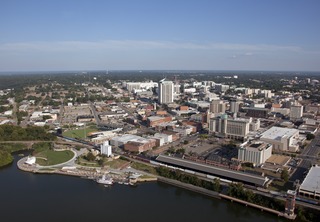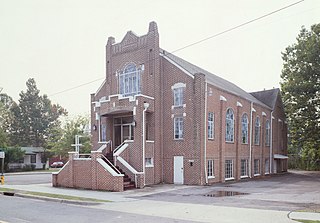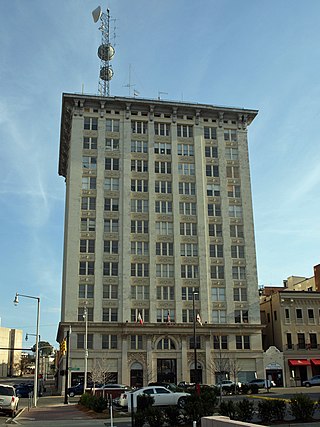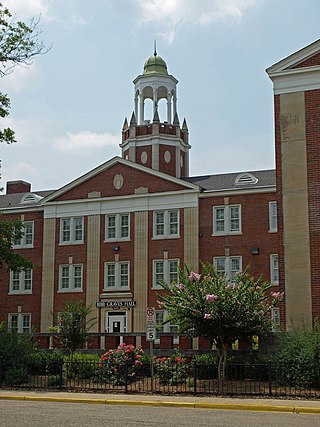
Montgomery is the capital city of the U.S. state of Alabama and the county seat of Montgomery County. Named for Continental Army Major General Richard Montgomery, it stands beside the Alabama River, on the coastal Plain of the Gulf of Mexico. In the 2020 census, Montgomery's population was 200,603. It is the second most populous city in the state, after Birmingham, and is the 119th most populous in the United States. The Montgomery Metropolitan Statistical Area's population in 2020 was 386,047; it is the fourth largest in the state and 142nd among United States metropolitan areas.

Mount Vernon is a neighborhood of Baltimore, Maryland, located immediately north of the city's downtown. It is named for George Washington's Mount Vernon estate in Virginia, as the site of the city's Washington Monument.
Athens State University is a public upper-division university in Athens, Alabama. Its academics are housed in three colleges: Education, Arts and Sciences, and Business.

Dexter Avenue Baptist Church is a Baptist church in Montgomery, Alabama, United States, affiliated with the Progressive National Baptist Convention. The church was designated as a National Historic Landmark in 1974 because of its importance in the civil rights movement and American history. In 1978 the official name was changed to the Dexter Avenue King Memorial Baptist Church, in memory of Dr. Martin Luther King Jr., who was pastor there and helped organize the Montgomery bus boycott in 1955 during the civil rights era. The church is located steps away from the Alabama State Capitol.

Huntingdon College is a private Methodist college in Montgomery, Alabama. It was founded in 1854 as a women's college.

Bellingrath Gardens and Home is the 65-acre (26 ha) public garden and historic home of Walter and Bessie Bellingrath, located on the Fowl River near Mobile, Alabama. Walter Bellingrath was one of the first Coca-Cola bottlers in the Southeast, and with his wealth built the estate garden and home. He and his wife, Bessie, lived in the home which has since been converted into a museum. The gardens opened to the public in 1932. The site was listed on the Alabama Register of Landmarks and Heritage on September 14, 1977, and on the National Register of Historic Places on October 19, 1982.

Brewerytown is a neighborhood in the North Philadelphia section of Philadelphia, Pennsylvania, United States. An unofficial region, Brewerytown runs approximately between the Schuylkill River's eastern bank and 25th Street, bounded by Montgomery Avenue to the north and Parrish Street to the south. Brewerytown derived its name from the numerous breweries that were located along the Schuylkill during the late 19th century and early 20th century. It is now primarily a residential neighborhood, with a growing and active commercial sector along Girard Avenue.

The Mount Zion African Methodist Episcopal Zion Church, also known as the Mount Zion AME Zion Church Memorial Annex, is a historic church in Montgomery, Alabama, United States. Located on 467 Holt Street, it was built in 1899 and extensively remodeled in 1921.

Bethel Baptist Church is a Baptist church in the Collegeville neighborhood of Birmingham, Alabama. The church served as headquarters from 1956 to 1961 for the Alabama Christian Movement for Human Rights (ACMHR), which was led by Fred Shuttlesworth and active in the Birmingham during the Civil Rights Movement. The ACMHR focused on legal and nonviolent direct action against segregated accommodations, transportation, schools and employment discrimination. It played a crucial role in the 1961 Freedom Rides that resulted in federal enforcement of U.S. Supreme Court and Interstate Commerce Commission rulings to desegregate public transportation.

St. Luke's Episcopal Church is a historic Carpenter Gothic church, built during the 1850s at Cahaba, the first capital of Alabama from 1820 to 1826. The unknown builder closely followed plans published by architect Richard Upjohn in his 1852 book Rural Architecture.

Verbena, also known as Summerfield, is an unincorporated community in southeastern Chilton County, Alabama, United States. Named for the indigenous flower, Verbena developed into a popular resort location for the more affluent citizenry of Montgomery, the state's capital, during the yellow fever outbreaks of the late 19th and early 20th centuries. Many stately homes, some of which have undergone recent renovation and restoration, line the streets of the town as a reminder of this historic past.

Eastern Female High School, also known as Public School No. 116, is a historic female high school located on the southeast corner of the 200 block of North Aisquith Street and Orleans Street, in the old Jonestown / Old Town neighborhoods, east of Downtown Baltimore and now adjacent to the recently redeveloped Pleasant View Gardens housing project / neighborhood of Baltimore, Maryland, United States. It was built in 1869-1870 and is typical of the Italian Villa mode of late 19th-century architecture. It was dedicated in a large ceremony with speeches later published in a printed phamplet and attending crowds in early 1870. Old Eastern High is a two-story brick structure that features a square plan, three corner towers, and elaborate bracketing cornices, with a similar wood decorated porch/portico over front entrance on its west side facing Aisquith Street.

The Pennsylvania School for the Deaf is the third-oldest school of its kind in the United States. Its founder, David G. Seixas (1788–1864), was a Philadelphia crockery maker-dealer who became concerned with the plight of impoverished deaf children who he observed on the city's streets. The current school building is listed by the National Register of Historic Places, and two former campuses are similarly recognized.

The Bell Building is an office building located in downtown Montgomery, Alabama. It was built in 1907 by local businessman Newton J. Bell, and was the tallest building in Montgomery at the time. It was added to the National Register of Historic Places in 1981. The height of the building is 187 feet.

The Alabama State University Historic District is a 26-acre (11 ha) historic district at the heart of the Alabama State University campus in Montgomery, Alabama. It contains eighteen contributing buildings, many of them in the Colonial Revival style, and one site. The district was placed on the Alabama Register of Landmarks and Heritage on August 25, 1994, and the National Register of Historic Places on October 8, 1998.

The Garden District is a 315-acre (127 ha) historic district in Montgomery, Alabama.
Anthony Dickinson Sayre was an Alabama lawyer and politician who notably served as a state legislator in the Alabama House of Representatives (1890-1893), as the President of the Alabama State Senate (1896-97), and later as an Associate Justice of the Supreme Court of Alabama (1909-1931). He was influential in Alabama politics for nearly half-a-century.




















